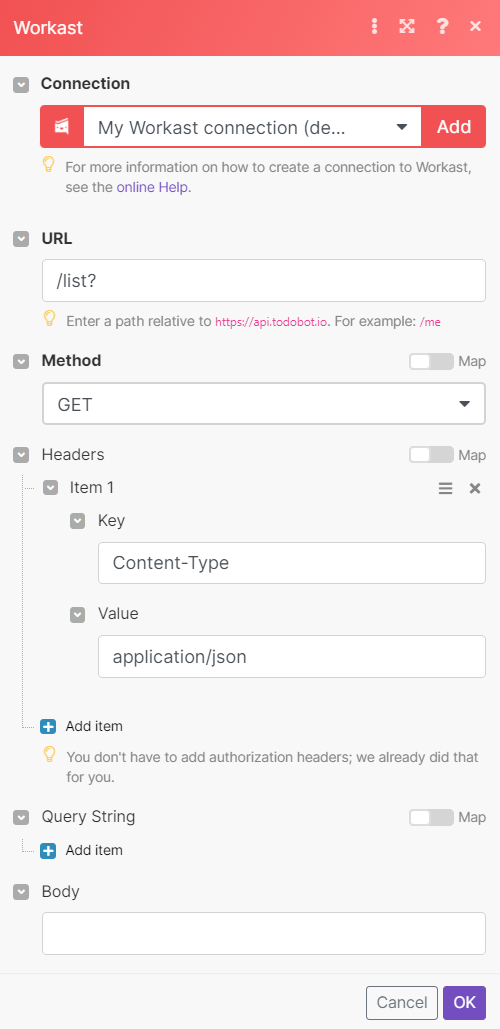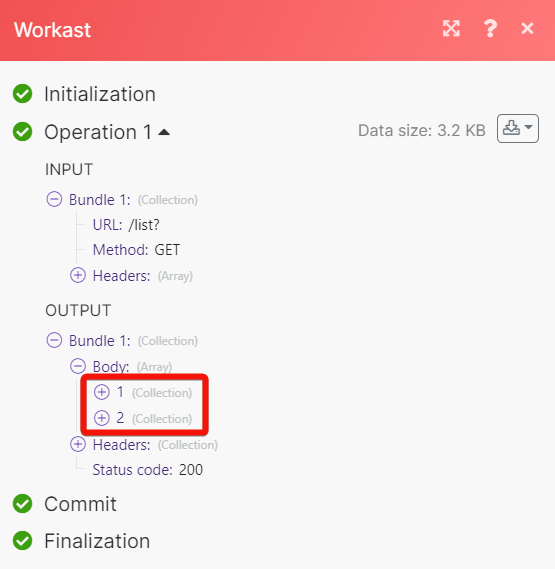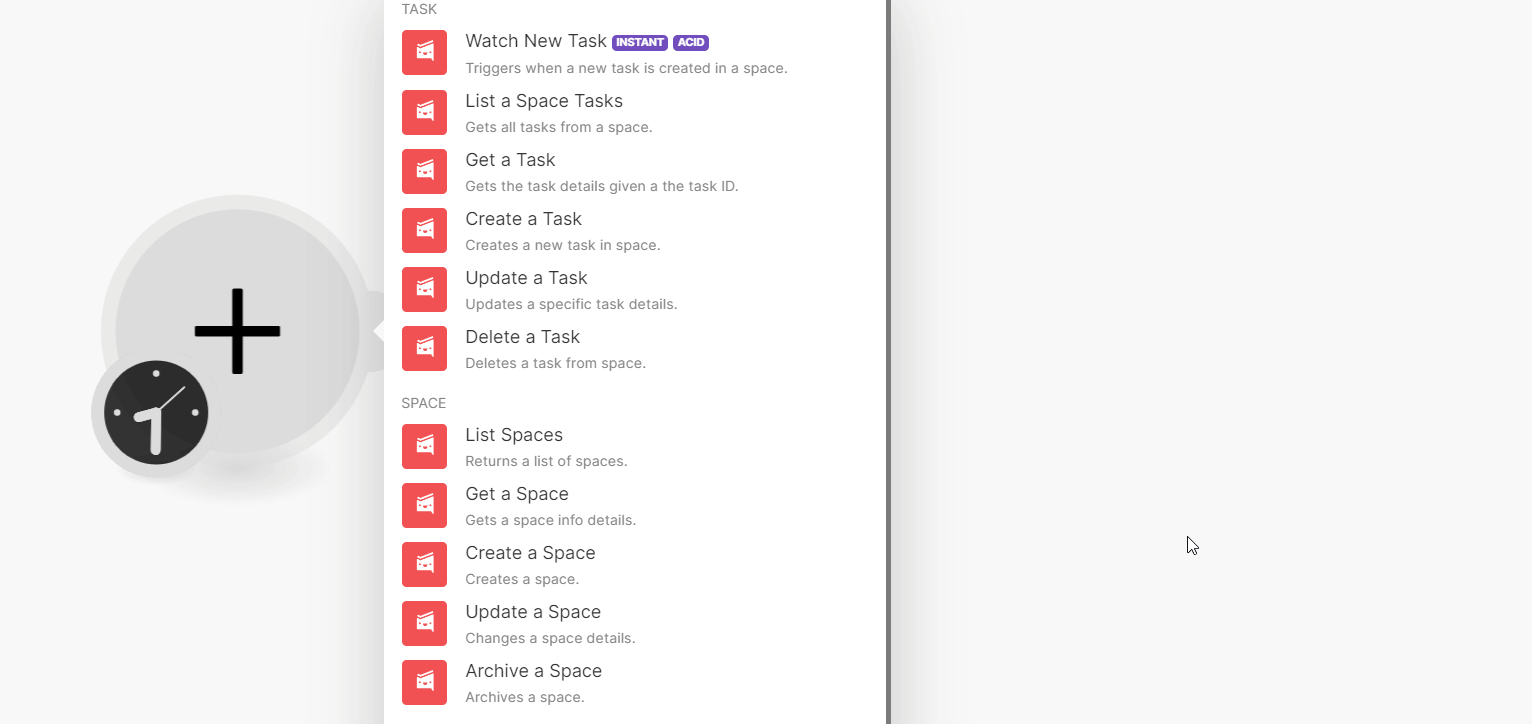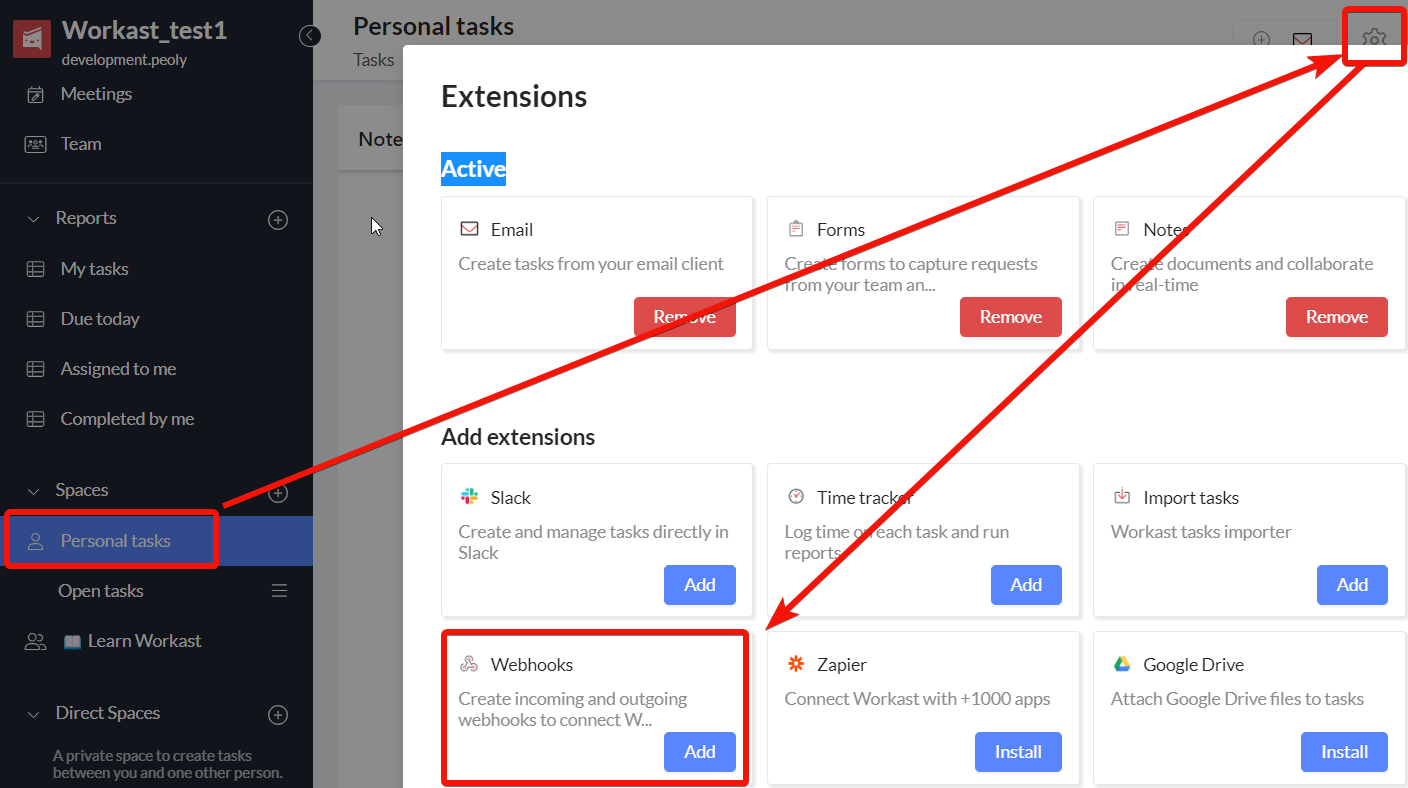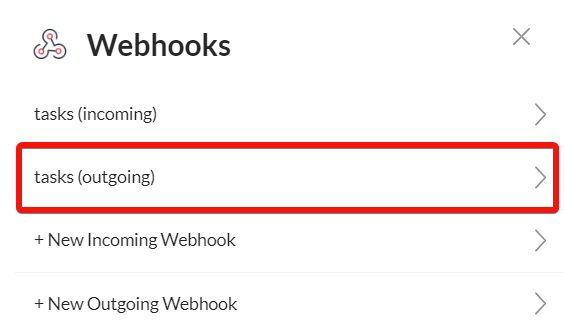| Active with remarks |
|---|
| This application needs additional settings. Please follow the documentation below to create your own connectionUnique, active service acces point to a network. There are different types of connections (API key, Oauth…). More. |
With the Workast modulesThe module is an application or tool within the Boost.space system. The entire system is built on this concept of modularity. (module - Contacts) More in Boost.spaceCentralization and synchronization platform, where you can organize and manage your data. More IntegratorPart of the Boost.space system, where you can create your connections and automate your processes. More, you can:
To get started with Workast:
-
create an account at workast.com
To connect Workast with Boost.space Integrator you need to obtain the API tokenThe API token is a multi-digit code that allows a user to authenticate with cloud applications. More from your Workast account:
-
Log in to your Workast account.
-
Click Your Account Name > Preferences > Generate TokenThe API token is a multi-digit code that allows a user to authenticate with cloud applications. More.
-
Copy the API Token to a safe place.
-
Log in to your Boost.space Integrator account, and add a moduleThe module is an application or tool within the Boost.space system. The entire system is built on this concept of modularity. (module - Contacts) More from the Workast app into a Boost.space Integrator scenarioA specific connection between applications in which data can be transferred. Two types of scenarios: active/inactive. More.
-
Click Add next to the Connection field.
-
In the Connection name field, enter a name for the connection.
-
In the API Token field, enter the token copied in step 3 and click Save.
You can watch, list, retrieve, create, update and delete tasks using the following modules.
TriggersEvery scenario has a trigger, an event that starts your scenario. A scenario must have a trigger. There can only be one trigger for each scenario. When you create a new scenario, the first module you choose is your trigger for that scenario. Create a trigger by clicking on the empty module of a newly created scenario or moving the... when a new task is created in a spaceSubunits are created within modules to maintain organization and clarity, even with large amounts of data. More.
|
WebhookA webhook is a way for an app to send real-time information to a specific URL in response to certain events or triggers. Name |
Enter the name of the webhook. |
|
Connection |
For setting up webhooksA webhook is a way for an app to send real-time information to a specific URL in response to certain events or triggers., see Setting Up Workast Webhooks.
Gets the task details given task ID.
|
Connection |
|
|
Space ID |
Select or map the Space ID whose task you want to list. |
|
Limit |
Set the maximum number of tasks Boost.space Integrator will return during one scenario execution cycleA cycle is the operation and commit/rollback phases of scenario execution. A scenario may have one or more cycles (one is the default).. |
|
StatusCreate statuses for each module separately to create an ideal environment for efficient and consistent work. More Is |
Enter (map) the status of the task you want to list. For example, |
|
Order |
Select the order in which you want to list the tasks:
|
Gets the task details given the task ID.
|
Connection |
|
|
Space ID |
Select or map the Space ID whose task details you want to retrieve. |
|
Task ID |
Select or map the Task ID whose details you want to retrieve. |
Creates a new task in space.
|
Connection |
|
|
Space ID |
Select or map the Space ID in which you want to create a task. |
|
Text |
Enter the task main text such as a subject line or a heading. |
|
Description |
Enter the task details. |
|
Assigned To |
Select the usersCan use the system on a limited basis based on the rights assigned by the admin. More to whom the task is assigned. |
|
Assigned To Email |
Add the email addresses of the users to whom the task is assigned. |
|
Start Date |
Enter the date when the work on the task has started. See the list of supported date and time formats. |
|
Due Date |
Enter the date by which the task must be completed. See the list of supported date and time formats. |
|
Frequency |
Select the frequency of the task to be performed. For example, |
|
Interval |
Enter the interval at which the task must be performed. |
|
By Week Day |
Select or map the days on which the task repeats. |
|
By Set POS |
Select or map the task occurrence. Each given integer specifies an occurrence number, corresponding to the nth occurrence of the rule inside the frequency period. The value 0 is not valid. The valid value(s) are -1, 1, 2, 3, and 4. |
Updates specific task details.
|
Connection |
|
|
Space ID |
Select or map the space whose task details you want to update. |
|
Task ID |
Select or map the Task ID whose details you want to update. |
|
Text |
Enter the task main text such as a subject line or a heading. |
|
Description |
Enter the task details. |
|
Start Date |
Enter the date when the work on the task has started. See the list of supported date and time formats. |
|
Due Date |
Enter the date by which the task must be completed. See the list of supported date and time formats. |
|
Use Common List |
Select whether you want to add the task to the common list. |
|
Repeat |
Add the repeat options if this is a repetitive task. |
|
Frequency |
Select or map the frequency of the task. For example, |
|
Interval |
Enter the interval at which the task repeats. |
|
By Weekday |
Select the days on which the task repeats. |
|
By Set POS |
Select or map the task occurrence. Each given integer specifies an occurrence number, The value 0 is not valid. The valid value(s) are -1, 1, 2, 3, and 4. |
Deletes a task from space.
|
Connection |
|
|
Space ID |
Select or map the Space ID whose task details you want to delete. |
|
Task ID |
Select or map the Task ID you want to delete. |
You can list, retrieve, create, update, and archive spaces using the following modules.
Returns a list of spaces.
|
Connection |
|
|
Only UserCan use the system on a limited basis based on the rights assigned by the admin. More Lists |
Select to filter sublist only where the user is a participant of the List. |
|
Limit |
Set the maximum number of spaces Boost.space Integrator should return during one scenario execution cycle. |
|
Type |
Select the space type which you want to list: |
Gets space info details.
|
Connection |
|
|
Space ID |
Select or map the Space ID whose details you want to retrieve. |
Creates a space.
|
Connection |
|
|
Participants |
Select or map the User ID whom you want to add to the space. |
|
Description |
Enter (map) the space details. |
|
Type |
Select the space type:
|
|
Privacy |
Select the space visibility:
|
|
Name |
Enter (map) a name for space. |
|
Channel ID |
Enter (map) the Channel ID. |
|
Channel Name |
Enter (map) the channel name. |
|
Apps |
Add the apps for space. |
|
Send Notifications |
Select whether you want to send the notifications to users regarding the space. |
Changes space details.
|
Connection |
|
|
Space ID |
Select or map the Space ID whose details you want to update. |
|
Name |
Enter (map) a name for space. |
|
Slug |
Enter (map) the list details of the space. |
|
Description |
Enter (map) the details of the space. |
|
Channel ID |
Enter (map) the Channel ID. |
|
Channel Name |
Enter (map) the channel name. |
|
Task Created |
Select whether the task is created in the space. |
|
Task Completed |
Select whether the space’s tasks are completed. |
Archives a space.
|
Connection |
|
|
Space ID |
Select or map the Space ID you want to archive. |
You can call APIs using the following module.
Performs an arbitrary authorized API call.
|
Connection |
||||
|
URL |
Enter a path relative to
|
|||
|
Method |
Select the HTTP method you want to use: GET to retrieve information for an entry. POST to create a new entry. PUT to update/replace an existing entry. PATCH to make a partial entry update. DELETE to delete an entry. |
|||
|
Headers |
Enter the desired request headers. You don’t have to add authorization headers; we already did that for you. |
|||
|
Query String |
Enter the request query string. |
|||
|
Body |
Enter the body content for your API call. |
The following API call returns the spaces from your Workast account:
URL:
/list?
Method:
GET
Matches of the search can be found in the module’s Output under BundleA bundle is a chunk of data and the basic unit for use with modules. A bundle consists of items, similar to how a bag may contain separate, individual items. More > Body.
In our example, 2 spaces were returned:
To set up the Workast webhooks:
-
Open the Watch Tasks module, create a connection, click Save, ad copy the URL address to your clipboard, click OK and save the triggerEvery scenario has a trigger, an event that starts your scenario. A scenario must have a trigger. There can only be one trigger for each scenario. When you create a new scenario, the first module you choose is your trigger for that scenario. Create a trigger by clicking on the empty module of a newly created scenario or moving the....
-
Log in to your Workast account.
-
From the left, click Personal Tasks > Settings > Extensions > Webhooks.
-
Click Add.
-
Click New Outgoing Webhooks and enter the following details.
Name
Enter a name for the webhook.
Target URL
Enter the URL address copied in step 1.
Receive tasks created
Select the checkbox if you want to receive triggers when new tasks are created.
Receive tasks completed
Select the checkbox if you want to receive triggers when tasks are completed.
Receive tasks updates
Select the checkbox if you want to receive triggers when tasks are updated.
-
Click Create.

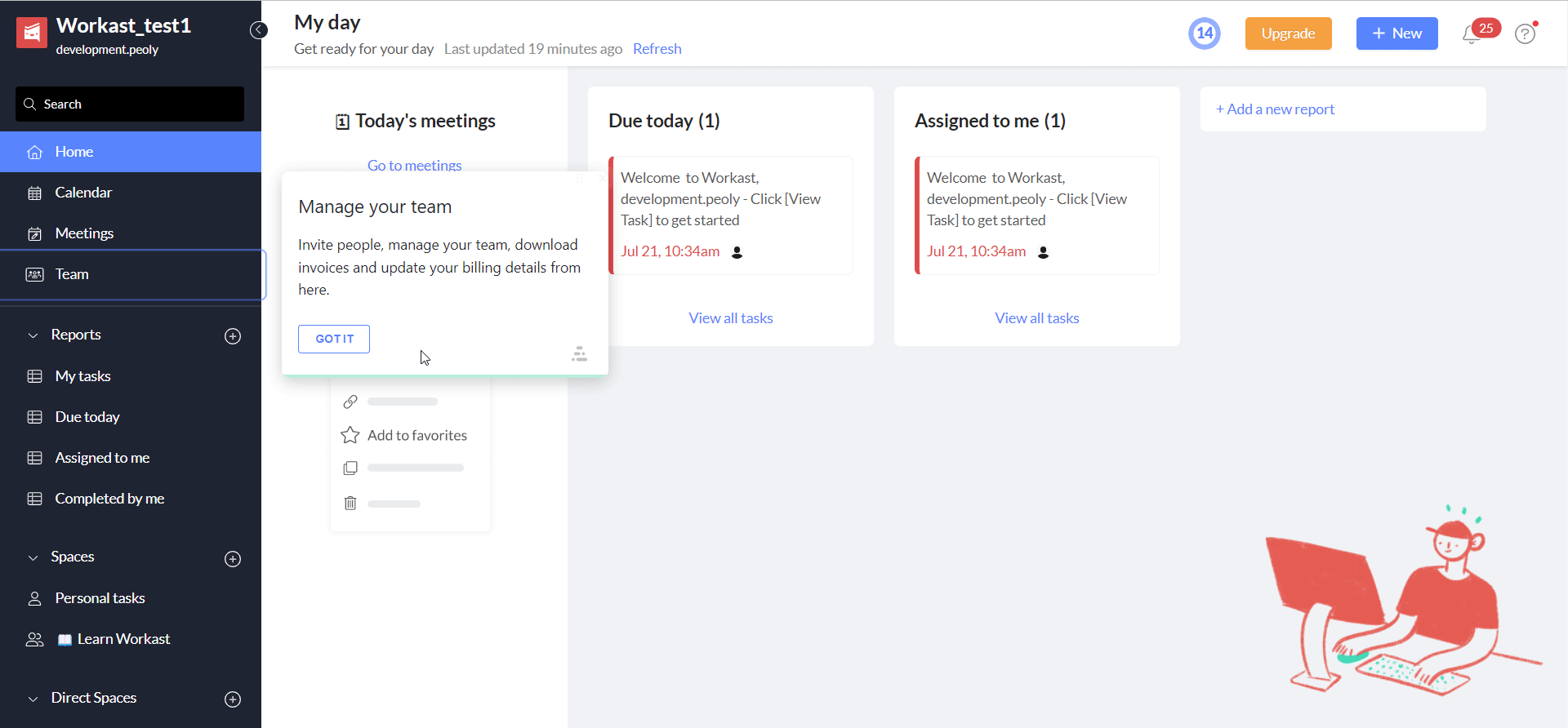

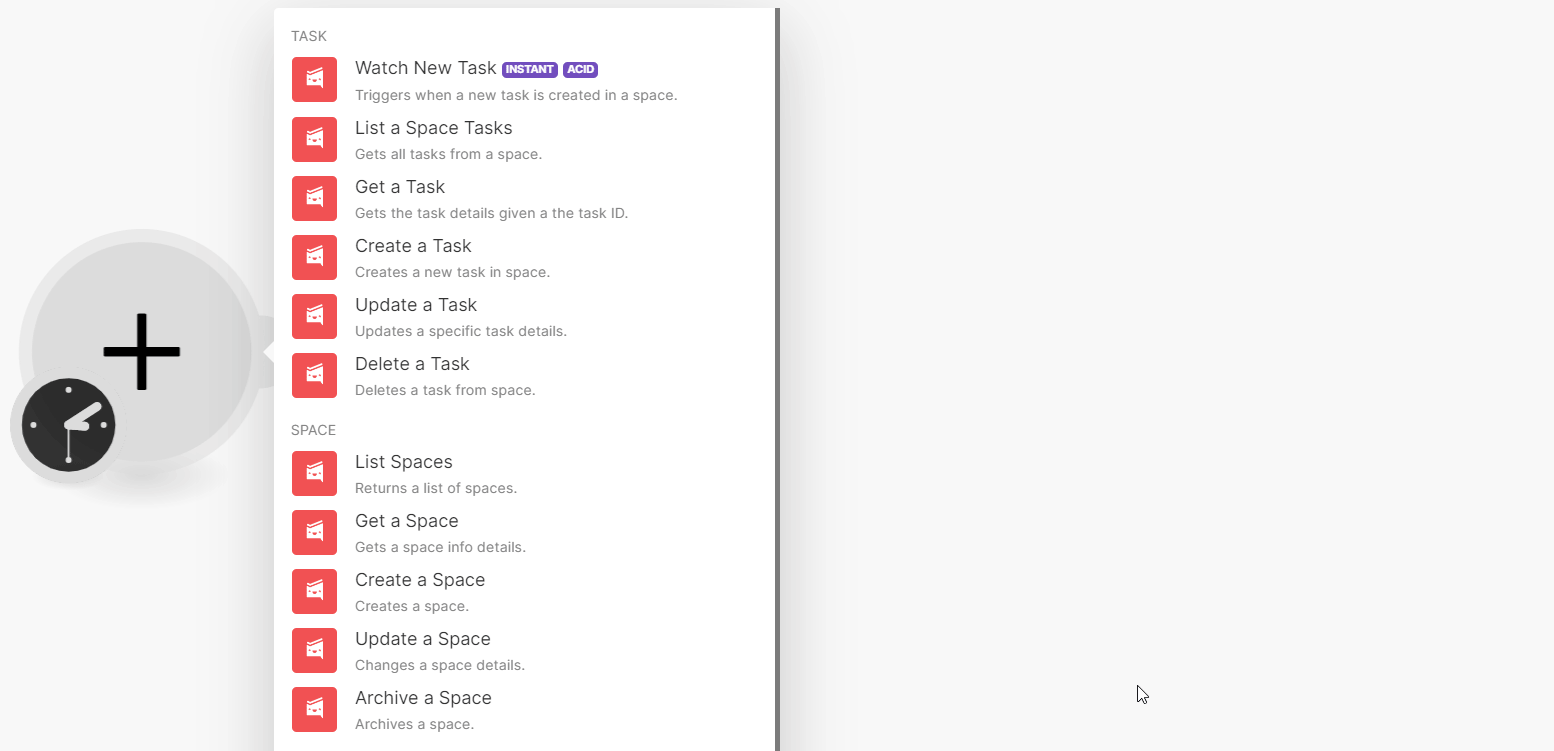
![[Note]](https://docs.boost.space/wp-content/themes/bsdocs/docs-parser/HTML/css/image/note.png)
